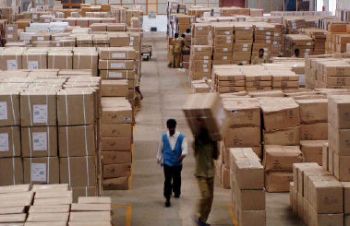A simple security tape and label on cargo moving continental distances can be a cost-effective and practical deterrent against theft and terror. Some companies in Europe, for example Tesa Bandfix AG, have developed such a package tape and security label to secure small parcels and cardboard boxes as well as full pallets and rolling containers, especially relevant to high-value goods.
The self-adhesive security tapes can be affixed either manually or by mechanical processing. The label too can be attached automatically or by hand. The label, security seal and packaging tape can all be custom-printed with a company’s own logo, or with bar codes, or other client-specific information.
Tesa Holospot is a label bearing a tiny information field, measuring only a few sq.mm. A high-resolution laser lithograph is used to imprint the data carrier with information used, such as the time, date, machine, components and destination.
Any illegitimate tampering or opening of the shipment becomes instantly visible. The holospot method can also be integrated into a manufacturing process and thus enable original products to be protected from counterfeiting.
The text “opened” appears in colour; the marking remains clearly visible even if the tamperer attempts to stick the label back on, thereby enabling the security of the cargo to be verified at every stage in the supply chain.
Tesa's security products facilitate controls during inventory itself in the manufacturer’s warehouse. These devices are being used by leading automobile manufacturer DaimlerChrysler, mail-order corporation Tchibo, the mobile phone network operator T-Mobile, crystal company Swarovsky, and airport retailer The Nuance Group.
First line of defence : It is much like the familiar security seal on maritime containers that is still seen as the first line of defence against container theft and terrorism. The humble seal is assuming a new ‘dimension’, with a new standard — ISO – 17712. The use of new ‘mechanical’ seals comprises all types of bolt, cable or higher-strength bracket designs.
ISO-18185 has further approved two radio frequencies for the electronic version. One is 434MHz, and encompassed by technology currently on offer from Savi Technology; the other is 2.4GHz, presently favoured by GE Security, working in conjunction with Siemens and Mitsubishi Corp.
The complexity and high price of the e-seal alternatives continue to be deterrents to their more widespread use, in comparison with simpler and much cheaper passive bolt or cable seal. Whereas the US Department of Homeland Security (DHS) has long desired the use of ISO-17712 as a means to establish a minimum security requirement for all containers transiting US ports, the draft standard was endorsed by the World Customs Organisation and the World Shipping Council in 2005.
The mainstream development of a ‘smart’ electronic seal continues to be viewed as the logical progression.
Protect the supply chain : Supply chain security is an expensive proposition. Since the 1988 bombing of Pan Am flight 103, a score of directives have been issued that have substantially increased the security workload.
Post-9/11, one of the newer, more stringent cargo security systems emerged by way of the entry into force (July 1, 2004) of the amendments to the 1974 International convention for the Safety of Life at Sea (SOLAS), including the ISPS (International Ship and Port Facility Security) Code adopted in 2002 by IMO (International Maritime Organisation). These amendments cast new obligations on governments, ports, ship-owners and operating companies.
The HR 1 Law, a new anti-terrorism legislation signed by President Bush in August 2007, prescribes that every single container originating from outside the US and destined for the US must be scanned, with effect from July 1, 2012. The stipulation will apply sooner to airfreight imports, i.e., from July 2010.
Implementing security is a management as well as a technical problem. Technology is necessary, but not sufficient. For container inspection it is generally agreed that, to minimise disruptions to cargo flow, non-intrusive examination using x-ray or gamma ray systems be deployed. Radio-graphy equipment has been used at ports such as Singapore, Busan, Salalah, Southampton, Port Qasim and Puerto Cortes in Honduras. Terminal operators in Hong Kong have been using scanners effectively without disruption of traffic.
As the price of liberty is eternal vigilance, so is some inevitable cost on account of a reasonable security mechanism.
Date : 15/09/2008
Courtesy : Businessline
